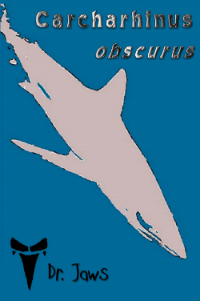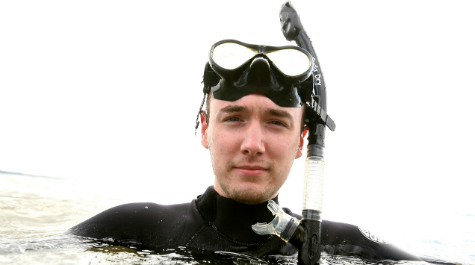Student combines love of sharks and art in new ‘Dr. Jaws’ book
Sharks aren’t known for being particularly relatable to humans. For most people, the image of a giant great white breaching the waves – all jaws and teeth – in pursuit of a desperately fleeing seal is their only conception of the ocean’s apex predator.
Dr. Jaws paints a different picture – literally.
In Carcharhinus obscurus, a book released this July, Dr. Jaws – better known as biology major Zach Nicholls ’14 – uses his own artwork, poetry and prose to make an unexpected point: We’re more like sharks than we think.
It’s an unorthodox approach to be sure, but Nicholls believes his hybridized approach of art and science might be what some people need to see these creatures in a new light.
‘Nature is the ultimate form of art’
An avid snorkeler and certified scuba diver, Nicholls has loved nature – particularly sharks – from an early age. As he approached college, however, he struggled to decide what form that love would take.
“I have a very artistic side. I love drawing, painting and music, so I started to drift away from the sciences,” he said. “But nature is the ultimate form of art in a way, so I thought that in itself would capture me and take me away from art purely and translate into a completely scientific program.”
Nicholls’ biology studies at William & Mary naturally brought him in contact with the Virginia Institute of Marine Science, where he fell in love with fieldwork. He participated in a variety of projects, including nighttime plankton trawls at Gloucester Point and the Eastern Shore and his favorite project, the VIMS shark survey.
The survey, established in 1973 by Jack Musick, is the oldest fishery-independent study of shark populations in the world. According to Nicholls, survey researchers put out lines to simulate commercial fishery operations and record which shark species are captured then released.
“It’s an interesting assessment of biodiversity,” Nicholls said, noting that the study also measures problems that fishery operations pose to shark populations.
These experiences working with sharks in the wild as a scientist have helped Nicholls reconcile his artistic and scientific sides.
“A shark is an animal. It has blood and muscle and capillaries. We know the cells and we know the molecules. It doesn’t make it any less awe-inspiring or magnificent,” he said. “Going in as a scientist, I realized I wanted to capture that more. Unfortunately, the sciences are not the most easily approachable fields of study.”
‘It is me on paper’
 Growing up, Nicholls played with the idea of presenting sharks in a creative medium. In January 2011, he wrote the poem that would later become the opening section of Carcharhinus obscurus.
Growing up, Nicholls played with the idea of presenting sharks in a creative medium. In January 2011, he wrote the poem that would later become the opening section of Carcharhinus obscurus.
This first poem was a catalyst that led Nicholls to think through how he would approach a full book about sharks. Using poetry and art to present sharks to a general audience soon struck him as the most obvious choice given his talents.
“Sharks are living poetry,” Nicholls said. “I tried to capture the spirit of what I personally felt when I was approaching each of these different subjects.”
The book is divided into three sections. The first predominately uses poetry and art to characterize each taxonomic classification from kingdom to species, ultimately focusing on the titular Carcharhinus obscurus – the dusky shark.
Nicholls’ scientific side makes itself known in the middle section, which characterizes the dusky shark as a species: habits, habitats and distinguishing features. While Nicholls is quick to note that this section isn’t a peer-reviewed shark study, he did substantial research to ensure that the information is as accurate as possible.
The final section, titled “Sea of Sauda,” unites the artistic and scientific aspects of the book’s earlier sections in a philosophical short story in which the book’s message becomes apparent.
“We’re more connected to animals and nature than we think or would like to think,” he said. “We both have this common element that we are alive and we’re constrained by the same laws. That, to me, is incredibly fascinating.”
Given the clear reflection of its author’s passions, the book was intended as much for Nicholls himself as any reader.
“I wanted to make it clear and approachable, but I never wanted to write for anyone. It’s really more that I wanted to do this and I wanted to make something that I think is beautiful,” he said. “It is me on paper.”
What’s next for Dr. Jaws?
Deep Sea Publishing, a Florida publishing house with an office in Herndon, Va., published Carcharhinus obscurus in July 2013. Nicholls sought publishers with the mindset that if none worked out, he could fall back on self-publication.
To his surprise, Deep Sea – only the sixth publisher he contacted – was interested in the book. Since then, his relationship with the publisher has only strengthened.
Carcharhinus obscurus specifically addresses the dusky shark, which seems like an odd decision for an author interested in all kinds of sharks. For Nicholls and his publisher, it was a strategic choice.
“It was in the hope – the realized hope – of making this into a series where different species are covered. I’m currently working on the second book right now. My publisher approved it, so I’ll be submitting it over fall break and hopefully it will be released in the winter,” Nicholls said.
The future looks bright for Nicholls, who hopes to expand his “Dr. Jaws” identity beyond books and into other forms of media.
“I actually love the idea of being Dr. Jaws as my career,” Nicholls said. “I’d love to do a kid’s show.”
Carcharhinus obscurus is available on major online booksellers and the VIMS gift shop, as well as from Nicholls himself—he keeps five copies in his bookbag at all times.



















